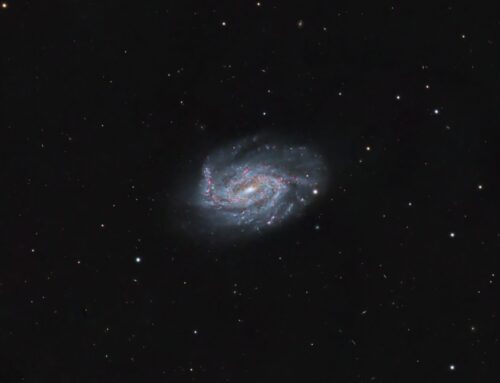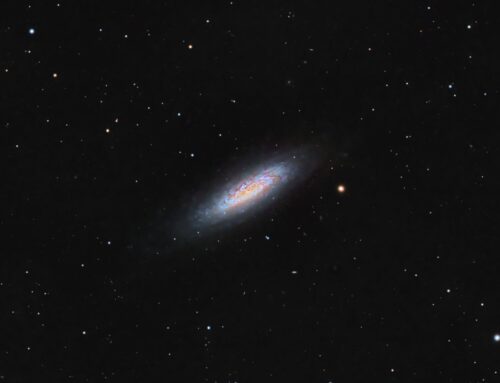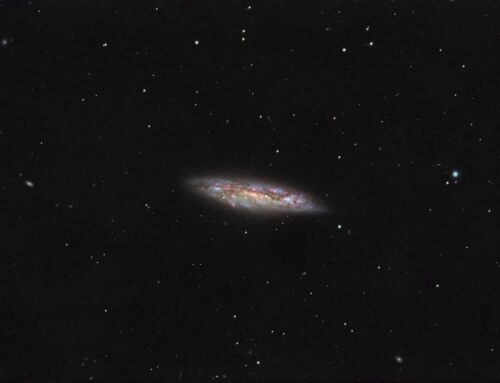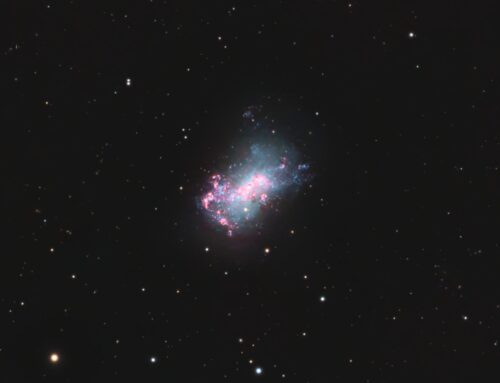NGC660, Polar-Ring Galaxy
 Click image for full size version
Click image for full size version
September 19, 2016; Featured on space.com Oct 24 2016
 NGC660, near the centre of the image, is one of relatively few galaxies in its class, referred to as a “polar ring galaxy.” It is located in Pisces, and lies about 45 million light years from Earth. There are a couple of theories of how the ring formed. It might have resulted from a merger with another galaxy, or NGC660 may have captured matter from a passing galaxy, which then formed a ring over time. The central region of NGC660 has a great deal of star formation occurring, and is considered a starburst galaxy, like M82. Detailed dust lanes are visible, and the ring shows plenty of structure too. The ring is 50,000 light years across; the galaxy about half that.
NGC660, near the centre of the image, is one of relatively few galaxies in its class, referred to as a “polar ring galaxy.” It is located in Pisces, and lies about 45 million light years from Earth. There are a couple of theories of how the ring formed. It might have resulted from a merger with another galaxy, or NGC660 may have captured matter from a passing galaxy, which then formed a ring over time. The central region of NGC660 has a great deal of star formation occurring, and is considered a starburst galaxy, like M82. Detailed dust lanes are visible, and the ring shows plenty of structure too. The ring is 50,000 light years across; the galaxy about half that.
There are dozens of other galaxies in this field. The most prominent is IC148 at upper left, lying about 36 million light years distant. The faintest galaxies in this image are on the order of 19th-20th magnitude and lie hundreds of millions of light years away.
Tekkies:
SBIG STL-11000M camera, Baader R, G and B filters, 10″ f/6.8 ASA astrograph, Paramount MX. Guided with SBIG’s external guide camera and 80 mm f/6.25 Lumicon achromatic refractor. Acquisition, guiding and mount control with TheSkyX. Focusing with FocusMax. Automation with CCDCommander. All preprocessing and post-processing in PixInsight. Shot from my SkyShed in Guelph, Ontario. Little to no moonlight, average and seeing throughout acquisition. Little or no moonlight.
20 x 15m Red, 20x15m Green and 18x15m Blue unbinned (total = 14hr30m).
RGB
Creation and cleanup: R, G and B masters were cropped and processed separately with multiple iterations of DBE. R, G and B were combined to make an RGB image which was processed with ColourCalibration.
Linear Noise Reduction: MultiscaleLinearTransform was used to reduce noise in the background areas. Layer settings for threshold and strength: Layer 1: 3.0, 0.5 Layer 2: 2.0, 0.35 Layer 3: 1.0, 0.2 Layer 4: 0.5, 0.1
Stretching: HistogramTransformation was applied to make a pleasing yet bright image. During stretching, it was noted that the colours were not properly balanced for the background, so this was adjusted manually using sliders for the individual colour channels, as well as the RGB/K slider.
Synthetic Luminance:
Creation and cleanup of SynthL: The cleaned up R,G and B masters were combined using the ImageIntegration tool (average, additive with scaling, noise evaluation, iterative K-sigma / biweight midvariance, no pixel rejection).
Deconvolution: A copy of the image was stretched to use as a deconvolution mask. A star mask was made from unstretched SynthL to use as a local deringing support. Deconvolution was applied (80 iterations, regularized Richardson-Lucy, external PSF made using DynamicPSF tool with about 20 stars; local deringing at 70% and global dark deringing at 0.03).
Linear Noise Reduction: MultiscaleLinearTransform was applied to reduce the noise. Layer settings for threshold and strength: Layer 1: 3.0, 0.5 Layer 2: 2.0, 0.35 Layer 3: 1.0, 0.2 Layer 4: 0.5, 0.1
Stretching: HistogramTransformation was applied to make a pleasing yet bright image.
Nonlinear Noise Reduction: TGVDenoise was applied and the image was re-stretched to reset the black point.
Combining SynthL with RGB:
The luminance channel of the RGB image was extracted, processed and then added back into the RGB image as follows:
1. Apply RGBWorkingSpace to equalize the channel weights for the three channels in the RGB image.
2. Extract luminance from the RGB image.
3. Apply LinearFit the extracted RGB luminance, using SynthL as the reference.
4. Use ChannelCombination in Lab mode to replace the RGB’s luminance with the fitted luminance from step 3.
5. Use LRGBCombine to make a SynthLRGB image with default settings.
Final Processing of SynthLRGB:
MultiscaleLinearTransform was applied to sharpen the brightest parts of the galaxy (bias +0.03 for layers 2 and 3, and bias +0.02 for layer 4), protecting other areas with a mask. Using the same mask, UnsharpMask was applied. Some mottling in the background was removed using the PixelMath expression:
iif($T<0.063, $T+0.75*(med($T)-$T), $T).
Background, stars and nebula brightness, contrast and saturation were adjusted in several iterations using Curves with masks as required.
Image scale is about 1.1 arcsec per pixel for this camera / telescope combination.






Excellent work!
Which documents / URLs do you use to get your work flow? I have been struggling with PI on and off for years.
I highly recommend the Book “Inside PixInsight” which was published in September 2016 and is part of the Patrick Moore Practical Astronomy series. Full disclosure: I was the Technical Reviewer/Editor for this book. You can get it from Springer at http://www.springer.com/us/book/9783319256801, and it’s also available at amazon or through the author directly at http://www.ip4ap.com/books/inside-pixinsight-by-warren-keller (with a personal inscription if you ask).